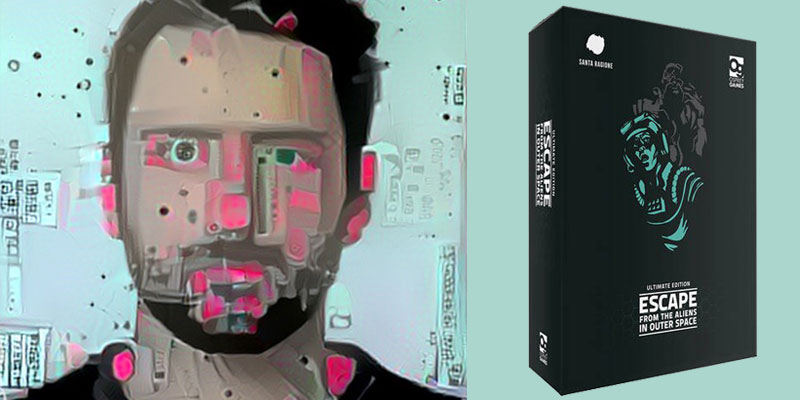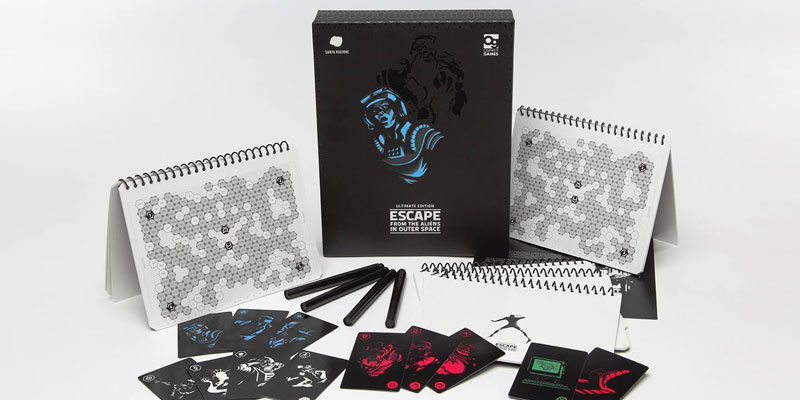Pietro Righi Riva on the big screen influences behind Escape From the Aliens in Outer Space

Pietro Righi Riva is the co-founder and director at Santa Ragione, an Italian design agency dedicated to creating experimental board games and video games.
Prior to launching video games including space adventure MirrorMoon, running experience Fotonica and driving game Wheels of Aurelia, Santa Ragione created Escape From the Aliens in Outer Space.
A game of strategy and bluff, Escape From the Aliens in Outer Space sees players secretly given a role as either a human or an alien. Playing out one of the eight maps included in the game, humans have to make their way out of a space station while aliens have to find and kill the humans before they escape.
Each time a player moves, they have to draw a card and state their position on the map. But – the card drawn may give you the option of lying about your position, a ingenuous move which allows savvy humans to lead aliens on a wild goose chase following a non-existent trail.
Deemed a “splendid, glorious liar’s convention” by Shut Up and Sit Down, the game was nominated for the Diana Jones Award for Excellence in Gaming and a swanky Ultimate Edition of Escape From the Aliens in Outer Space was released by Osprey Publishing last year.
We caught up with Riva to find out more about the origins of Escape From the Aliens in Outer Space and how Studio Ragione approaches designing both board games and video games.
How did Santa Ragione come together?
Me and Nicolò met online on game forums when we very young (I was 17!). We spent a lot of time talking about what games could and should be, until we started making our first game in 2010 (the board game Escape from the Aliens in Outer Space). In 2011 we met Paolo Tajé at a Global Game Jam, and we’ve been making games together since.
How would you describe the company’s approach to design?
Nowadays it’s searching for experimental solutions for interactive narratives that are accessible to non-gamers. We have some core beliefs regarding how our video games should always be recognisable from a single screenshot and how cinematography should be guided to achieve good composition through all gameplay.

Where did the idea for Escape from the Aliens in Outer Space come from?
We were trying to see if it was possible to reproduce in tabletop form the feeling of horror movies like Alien or The Thing. The whole game is designed around sensations, rather than systems. We started this project in university; three of the authors studied communication design together for over five years.
Are there design practices that you apply to designing both card games and video games, or are the mediums too radically different?
Absolutely. First of all are the interlocked concepts of accessibility and affordance. I’m not interested in designing games that require players to have played other titles before they can enjoy mine, because I want more people to approach this medium.
Accessibility hence is designing for the minimum attrition when approaching and learning the game: reducing explanations, difficulty, control complexity, etc. Good affordance plays a big part in this; that is designing elements so that they are self-explanatory in their use.
Have you got any card or board game projects in the pipeline?
We’ve been working with multiple prototypes over the last five years, but nothing close to a full product yet. We’d love to work on more board game projects because the design and iteration process is so much more satisfying than with video games, but unfortunately the margins are way too small to be a core activity for our studio.
Last year, you published a manifesto for non-traditional game design called Rejecta. Rules in there included: ‘All video game tradition in form, style and content must be rejected’ and ‘Setting must be strictly instrumental to content and meaning’. While conceived with video games in mind, are there any elements of your Rejecta manifesto that you feel apply to designing board games?
Yes absolutely.
I wrote Rejecta trying to summarise and write into usable best practices what I have been learning while making games and struggling to reach out to a culturally diverse audience, and that of course applies to the board games I worked on.
Naturally some concepts don’t adapt well (a board game cannot progress much without player participation) but many others – from the use of existing literature to submitting rules and systems to the meaning and setting – are applicable. Oh, and board games should definitely last less than two hours.
How do you stay creative?
It’s very important to look for inspiration outside of geekdom, and stay interested in other arts. As a team, we often tour film festivals and art exhibitions. I also recently found contemporary theatre to be an incredible source of inspiration for game designers.
Do you think the world of games is in a good place creatively at present?
Not really unfortunately. It’s struggling to expand its audience to meet the increasing production due to the vertiginous rise in accessibility to tools for game creation. In other words, creators are now struggling for the attention of a very specialised audience that has come to expect increasingly higher quality for lower and lower prices.
This is negatively moving the focus of the competition between authors away from the healthy creative side to a more perilous battle for cheaper labour that lowers working conditions for people in the industry and increases burnout rates.
























